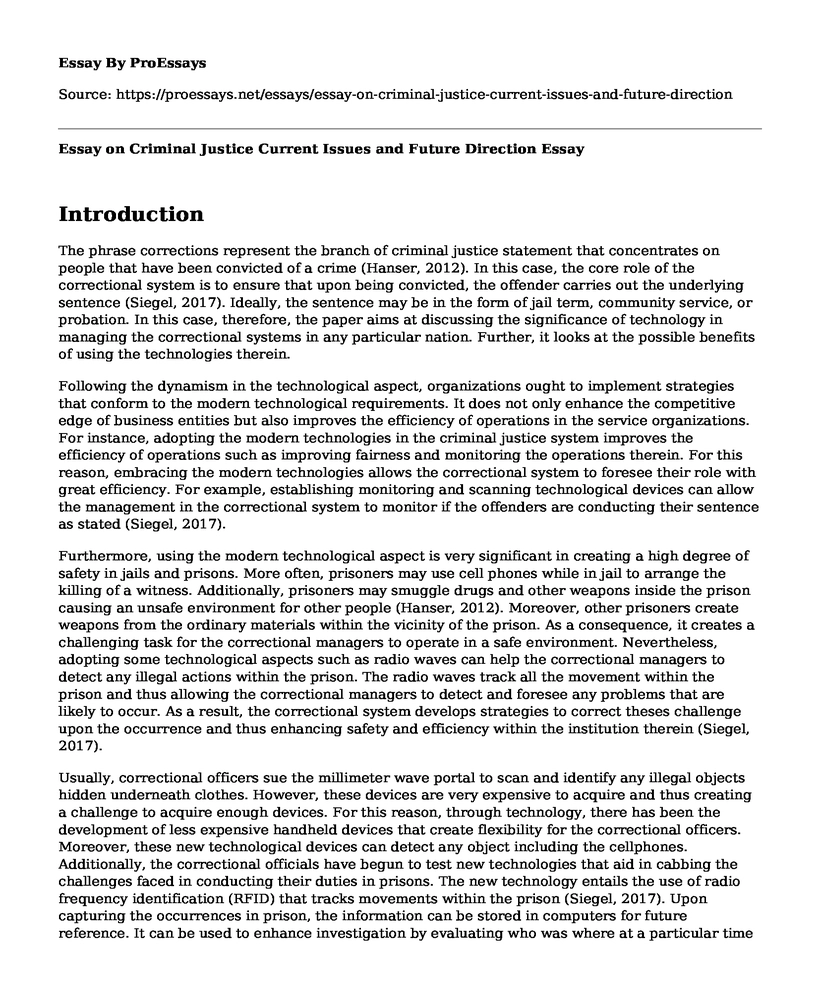Introduction
The phrase corrections represent the branch of criminal justice statement that concentrates on people that have been convicted of a crime (Hanser, 2012). In this case, the core role of the correctional system is to ensure that upon being convicted, the offender carries out the underlying sentence (Siegel, 2017). Ideally, the sentence may be in the form of jail term, community service, or probation. In this case, therefore, the paper aims at discussing the significance of technology in managing the correctional systems in any particular nation. Further, it looks at the possible benefits of using the technologies therein.
Following the dynamism in the technological aspect, organizations ought to implement strategies that conform to the modern technological requirements. It does not only enhance the competitive edge of business entities but also improves the efficiency of operations in the service organizations. For instance, adopting the modern technologies in the criminal justice system improves the efficiency of operations such as improving fairness and monitoring the operations therein. For this reason, embracing the modern technologies allows the correctional system to foresee their role with great efficiency. For example, establishing monitoring and scanning technological devices can allow the management in the correctional system to monitor if the offenders are conducting their sentence as stated (Siegel, 2017).
Furthermore, using the modern technological aspect is very significant in creating a high degree of safety in jails and prisons. More often, prisoners may use cell phones while in jail to arrange the killing of a witness. Additionally, prisoners may smuggle drugs and other weapons inside the prison causing an unsafe environment for other people (Hanser, 2012). Moreover, other prisoners create weapons from the ordinary materials within the vicinity of the prison. As a consequence, it creates a challenging task for the correctional managers to operate in a safe environment. Nevertheless, adopting some technological aspects such as radio waves can help the correctional managers to detect any illegal actions within the prison. The radio waves track all the movement within the prison and thus allowing the correctional managers to detect and foresee any problems that are likely to occur. As a result, the correctional system develops strategies to correct theses challenge upon the occurrence and thus enhancing safety and efficiency within the institution therein (Siegel, 2017).
Usually, correctional officers sue the millimeter wave portal to scan and identify any illegal objects hidden underneath clothes. However, these devices are very expensive to acquire and thus creating a challenge to acquire enough devices. For this reason, through technology, there has been the development of less expensive handheld devices that create flexibility for the correctional officers. Moreover, these new technological devices can detect any object including the cellphones. Additionally, the correctional officials have begun to test new technologies that aid in cabbing the challenges faced in conducting their duties in prisons. The new technology entails the use of radio frequency identification (RFID) that tracks movements within the prison (Siegel, 2017). Upon capturing the occurrences in prison, the information can be stored in computers for future reference. It can be used to enhance investigation by evaluating who was where at a particular time therein.
Conclusion
In conclusion, the modern technology is shaping the future of criminal justice system. As the technological becomes dynamic, the criminal justice system is finding the need to incorporate technological devices into the organizational operations. Although the process gradual, in the future, the criminal justice activities and the correctional system, in particular, will be fully automated.
References
Hanser, R. D. (2012). Introduction to corrections. London: SAGE
Siegel, L. J. (2017). Corrections today. Place of publication not identified: Cengage Learning
Cite this page
Essay on Criminal Justice Current Issues and Future Direction. (2022, Jun 30). Retrieved from https://proessays.net/essays/essay-on-criminal-justice-current-issues-and-future-direction
If you are the original author of this essay and no longer wish to have it published on the ProEssays website, please click below to request its removal:
- Intellectual Property: Research Paper Example
- Criminal Justice Assignment: Murder of Notorious B.I.G. Florence - Marie Cooper
- Essay Sample on Crime and Violence Trends
- Research Paper on Criminal Law
- Role of Terrorism in Homeland Security Paper Example
- Essay Sample on White Collar Crime
- Crime: Dangerous Acts & Our Justice System - Essay Sample







